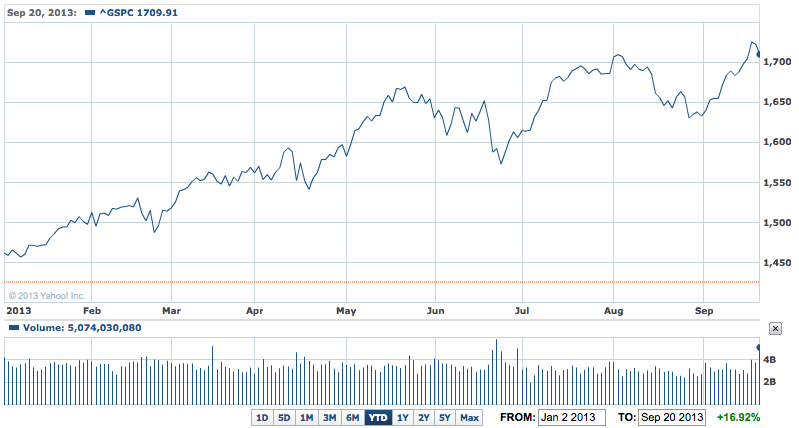Now it’s time for what you might call the ‘hangover effect’ after the brief party in the wake of the Fed’s surprise move last week not to start cutting its stimulatory spending.
Thursday saw the big gains, Friday saw the second thoughts and falls – especially on Wall Street – and today we will get more of that here and in Asian markets.
It was a timely reminder that the Fed’s non-decision merely postponed the start of the cuts to its stimulatory spending of $US85 billion a month and nothing else.
While that might change later today if the first of the monthly reports on the health of the Chinese manufacturing shows growth, the underlying story is that market volatility will rise as speculation continues about just when the Fed will start slowing its spending.
So our market will start on a weak note this morning after Wall Street’s second thoughts and fall on Friday.
The share price index futures contract was down 22 points at the close early Saturday morning, our time.
A solid report from China could change the market sentiment in Australia today, in particular after Friday’s reality reminder here and the bigger dose on Wall Street, and the fall in the Aussie dollar to 93.94 USc.
But the dollar was up around 1.5 USc for the week, a warning that it will remain higher for longer than industry and the Reserve Bank would feel comfortable with.
S&P 500 YTD – Fed’s tapering hangover hits markets

Economists and others continued to fight over the Fed’s decision.
One Fed member said on Friday the vote not to start tapering was close and it could happen at the central bank’s October meeting, if there was a noticeable improvement in the September jobs report.
But other economists pointed to the looming brawl in Washington over the budget and the debt ceiling as reasons why there wouldn’t be a decision at the Fed’s October meeting.
For that reason the December meeting looms as the most likely, but if the economy and the US jobs market remains weak, the actual decision could easily slip into 2014 with a new chairman of the central bank in place.
President Obama hardened his stance at the weekend, saying there would be no deal that saw his health care changes weakened in the spending bill, as it would with the House of Representatives legislation approved late last week by the hardline Republican majority.
The debt ceiling brawl will be a re-run of what we have seen before, but this time it could get tangled up with the budget argument.
Either way it worried the Fed, as Chairman Ben Bernanke said last week when he mentioned that concerns over the fiscal battle was a factor in the central bank’s surprise decision to maintain the size of its bond-buying program at $US85 billion a month.
Bernanke, in a news conference last week, said the Fed’s ability to offset shocks caused by budget battles is “very limited”, particularly in the case of a “debt-limit shock”.
Looking back at last week, the Fed’s decision would have produced big surges in markets if the week had ended on Thursday night (US time) with markets showing gains around the world.
But Friday saw gold, silver, copper and other commodities lose ground, and markets sell off – the Dow by 186 points or 1.2%.
But the Fed’s non decision did leave markets mostly higher over the week.
As a result, US shares had their third consecutive week of gains, although the key S&P 500 index fell 0.7% on Friday after hitting a record intra-day peak of 1,729.86 on Thursday.
During the week the US dollar fell more than 1%.
The yield on the 10-year Treasury bonds ended at 2.73%, down from a high of 2.9%.
Gold prices were slightly lower on the week at $US1,326 an ounce close in New York after Friday’s slump.
Gold prices fell 2.4% in regular trading, but fell further in after hours dealings to end down $US43 an ounce, or 3.16%. That told us just how precarious investors see gold – it couldn’t go on with Thursday’s $US61 an ounce surge.
Our market fell on Friday but ended the week up 1%.
That was better that the Dow’s 0.6% rise, but not the 1.3% rise for the Standard & Poor’s 500 or the 1.4% jump in the Nasdaq.













